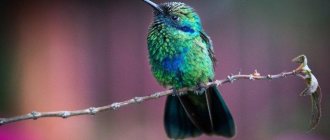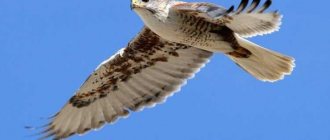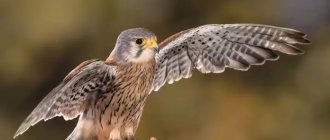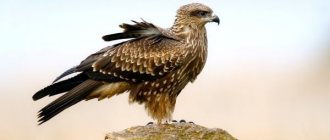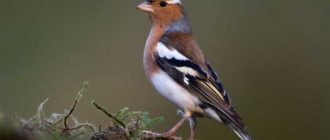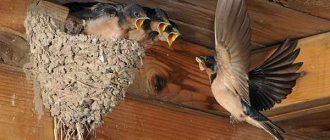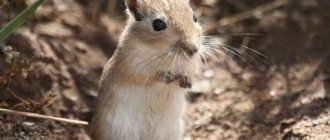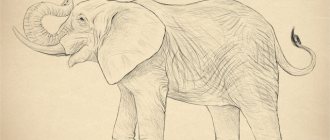Review author: “ZooVita”
The crow is a bird that has carried with it a shadow of darkness and mystery for many centuries. A characteristic feature of the bird is its intelligence, which is higher than that of many other representatives of the animal world. The crow's mind is comparable to that of a human and is at the level of thinking of a 4-year-old child.
Appearance of a crow bird
A typical crow has a long, thin build, narrow wings with long feathers, and a rounded cone-shaped beak.
The color of the bird's plumage is mainly black with a tint of blue or green. There are also representatives who have white or gray fluff at the base of the feather. The average weight of an individual reaches a maximum of 1.2 kilograms.
There is an opinion that crows can live for quite a long time, but there is no confirmation of this fact. When asked how long crows live, ornithologists unanimously agree that life expectancy in the wild is approximately 10-15 years; there are cases when the bird lived up to 20 years.
Interesting stories
The crow is a bird often called the winged rat for its intelligence and courage.
When feeding the chicks, adult females pre-soak the bread in puddles.
Crows are able to reproduce the sounds of human speech. Ornithologists say that these birds can solve simple logic problems. Birds distinguish between traffic lights. When it's red, they slowly eat carrion on the road. When the signal turns green, they quickly fly away.
Experts recorded the entertainment of crows. The birds, not far from the tennis court, got hold of a ball and began to bounce it around on the roof. The game ended only when the ball rolled down from the roof.
Crows steal the eggs of large birds - bustards and little bustards. They love to feast on other people's eggs.
In nature, the bird lives 10-60 years.
So, how do these birds differ?
Crow Bird Habitats
Coniferous forests are considered the favorite habitat of birds, but they are often found in urban environments. For nesting, crows choose an area away from human eyes, for example, in the desert, in the mountains or near a pond in the trees.
Crows prefer to settle in northern territories. Large populations can be found in Russia, North America, some regions of Europe and Asia.
Other differences
In addition to those listed earlier, there are other differences:
- The raven lives in subtropical and temperate climates in Eurasia and North America. The crow lives in Eurasia and Northeast Africa. This is the significant difference. Crows have a much more modest habitat.
- Lifespan. The life span of a raven is much longer than that of a crow. The average lifespan of the latter is 8 years. There are legends about the life of a raven, according to which they can live up to 300 years.
- The crow is not embarrassed by the proximity of a person. She calmly settles in cities. Raven is used to living alone or in pairs.
Crow lifestyle
Due to their high intelligence, crows teach their chicks skills for a long time. After the offspring grow up, as a rule, they do not leave the flock, so the accumulation of birds can grow to 50 individuals.
Birds can lead a nomadic lifestyle, quickly adapting to new conditions. However, there are flocks that live in the same place for a long time.
In search of food for the flock, they descend to the ground and can live near humans. Food is shared with weaker members of the family, uneaten food is hidden in the ground.
Thanks to their narrow wings and special feather structure, crows quickly take off without a run and can easily maneuver in the air, quickly moving their wings.
Another proof of the high level of intelligence of birds is circling over deceased relatives. The farewell ceremony ends with silence on the ground.
Offspring
Crows begin breeding when they reach the age of two years. Birds make couples. Nests are built from durable branches and placed on the tops of buildings or treetops.
In places where there are no people, the nest can be located on the ground. The female incubates the eggs. Their number is 4-6 pieces. The male takes care of the family's nutrition. After 17-19 days, the chicks appear. At first they are naked, and after a month they are covered with feathers.
Grown-up birds do not always form their own families; they often continue to live with their parents and help feed new generations of chicks.
How does a crow differ from other birds?
The most common misconception is that a raven and a crow are the same bird. The black raven is a member of a different species, but of the same genus. First of all, the size of the bird differs. The crow is smaller, the raven grows up to 2 kilograms. Its tail is long and wedge-shaped.
The raven prefers a solitary way of existence, so it chooses places away from crowds of people.
The flight of a raven is smooth, with sweeping movements of its wings. Before the raven takes off, it needs a short run-up.
Features of character and lifestyle
Photo: Carrion crow in nature
Carrion crows are very smart birds. They are known for their problem solving skills and amazing communication skills. For example, when a crow encounters a mean person, it teaches other crows how to identify him. In fact, research shows that black crows don't forget faces.
Fun fact: Intelligent black crows can be master imitators. They were taught to count out loud to seven, and some crows learned over 100 words and up to 50 complete sentences; others were known to imitate the voices of their owners to call dogs and tease horses. They also display great curiosity, harboring a reputation for inventive pranksters and counting thieves. They fly with people's mail, pull clothespins out of lines and run off with unattended items such as car keys.
Many species of crows are solitary, but they often forage in groups. Others remain in large groups. When one crow dies, the group will surround the deceased. These funerals do more than just mourn the dead. The black crows gather together to find out who killed their member.
After this, a group of crows will unite and chase the predators. Some species of crows are annual, non-mating adults, and live in a group called a perching community. Some crows migrate while others do not migrate. They will travel to warmer areas of their territory when necessary.
Carrion crows are well known for being solitary nesters, although they maintain extensive nesting territories around their nests. Interestingly, crows work together to provide protection from predators and other intruders.
They exhibit a peculiar behavior of leaning on a prominent object, such as a chimney or television antenna, and vocalizing a series of sharp, timed croaks quite loudly.
Fun fact: Carrion crows clean up dead animals and garbage. In fact, crows are often blamed for knocking over trash cans, but the real culprits are usually raccoons or dogs.
Types of crows
The Raven genus includes 9 species of birds. They are united by external similarity, but there are distinctive features. What a typical representative of the species looks like can be seen in the photo. The white crow does not exist as a species. White-winged crows are the result of a mutation called albinism.
Black Crow
It has a smooth, shiny charcoal plumage with a metallic green or purple sheen. The beak is short, the eyes and legs are completely jet black.
Birds live in some European countries and in the east. In Russia, they fell in love with Eastern Siberia.
Hoodie
Representatives of this species chose the Central part of Europe and the Western Siberian regions as their habitat.
All parts of the bird's body are black. The hooded raven is characterized by a curved, strong beak and a gray belly.
Bronze Crow
Lives in the eastern part of the African continent. It is distinguished by a huge, heavy beak, which is larger in size than the bird’s head.
The plumage is dark with a blue sheen, the back of the head is noticeably marked with a white spot. Usually such a crow grows up to 60 cm.
White-necked Crow
Although the color of the bird is black, there is white down at the base of the feathers on the neck, hence the name of the species. It has a small body weight - up to 600 grams.
White-necked crows live throughout North America.
Big-beaked crow
One of the largest species of crows leads a sedentary lifestyle in the countries of the East. Weight can reach 1.3 kilograms. Has a long, large beak. The plumage is dark gray, the feathers on the top of the head are slightly ruffled.
Australian Crow
One of three species found in the Australian state. Long beak. The wingspan with a turquoise tone can reach 1 meter.
The dark color of the plumage is typical for a crow; the main difference between Australian birds and others is their light eyes.
South Australian Crow
Also lives in Australia, mainly in Sydney. The average weight of a bird is only 500 grams. The plumage is dark, the eyes are light, the beak is narrow and sharp. South Australian crows gather in numerous families.
Bristle Crow
Despite the fact that the bird lives in one place for a long time, it can travel a long distance when searching for food. Light weight, narrow wings, and light feathers allow the bristly crow to fly several tens of kilometers.
They mainly settle in northern Africa and the Middle East. There have been cases of appearance in the area of the Arabian Peninsula.
The color differs in blue or copper tints.
Bangay crow
The smallest species of crow, weighing only 450 grams. Sharp, short beak, small wings. It has a jet black color, but the base of the feather is gray. It is on the verge of extinction.
Lives in the lands of Indonesia.
Sparrowhawk
The sparrowhawk is a small predator, smaller than a crow. It hunts mainly tits and sparrows. It attacks from an ambush like a goshawk, but can also hover in the air for a long time, looking for prey in the open space. Therefore, he prefers to settle in forests, near forest edges and meadows.
In Moscow, sparrowhawks lead a sedentary lifestyle. Pairs stay on a permanent nesting site, using the same nests in the treetops for several years. The chicks are hatched quite late; fledglings appear only in early July. With the birth of their young, birds can behave quite aggressively, sometimes even attacking a person who comes too close to the nest.
This species in Moscow has the third category of rarity. Sparrowhawks were observed in the natural and historical parks “Izmailovo”, “Bitsevsky Forest”, “Kuzminki-Lublino”, the Kuskovo Forest Park, in Serebryany Bor and in other natural areas.
What do crows eat in the wild?
The diet of the raven family is varied. Some birds limit themselves to food of plant origin, others hunt for food. To catch mice, small frogs and lizards, crows are usually grouped in groups of several individuals.
Worms and larvae are found on the ground and in trees. They can also stir up other people's nests and easily eat already born chicks.
Those who live close to people can steal leftover food and rummage through garbage.
Common buzzard
The common buzzard is a medium-sized predator. The color of its plumage is quite varied: from brown to grayish; below the body is lighter and motley. Stripes are clearly visible on the underside of the wings and tail.
You can distinguish the common buzzard from other members of the family during flight. When a bird soars for a long time, you can notice that its tail is wide open and its wings have a rounded shape.
The unusual name of the predator comes from the word “moan.” In flight, the bird makes a drawn-out sound with nasal “moaning” notes. Breeds in forests, near open spaces. Buzzards feed on small rodents and sometimes amphibians.
This is a migratory species, so buzzards almost never nest in the capital. For them, the city is a transit point; here they stop to rest. In the Red Book of Moscow, birds have the first category of rarity.
In recent years, birds have been spotted in the Kuzminki-Lublino park. And in the Bitsevsky Forest, buzzards can be consistently observed twice a year - in spring and autumn. In the territories of the TiNAO, the buzzard is more numerous, where its rarity category rises to third. And already in the Moscow region this species is considered the most numerous of birds of prey.
Interesting facts about crows
- Crows can imitate the voices of other birds or animals;
- Have a good memory;
- They are able to communicate with each other using their beak movements;
- Crows have greater intelligence than rooks;
- To get food he can use improvised objects.
Black kite
The black kite is a large bird with dark brown, almost black feathers. The kite can be easily distinguished from other predators by its characteristic forked tail. Migratory bird. Like many other birds of prey, it tries to stick to one nesting site for several years in a row. Kites settle in areas of the forest that are located near open spaces, usually near water bodies.
Birds eat small mammals, amphibians, fish and invertebrates. A significant part of their diet also consists of carrion and pasture. In Moscow, black kites are found mainly during the migration period. In the Red Book of the capital, the kite has the second category of rarity.
